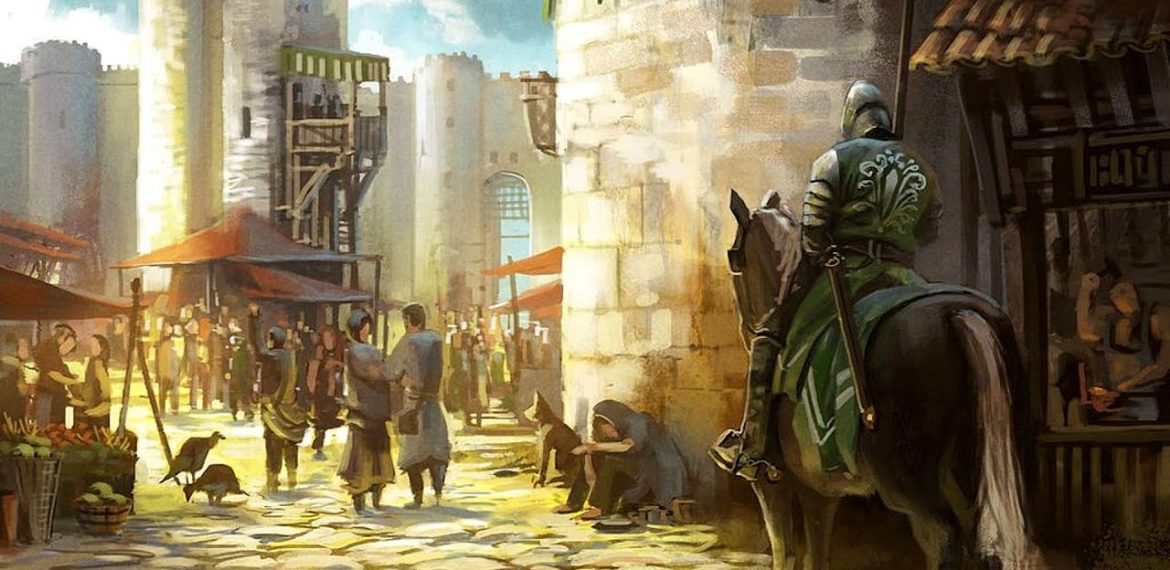The medieval city was seen as a crowded and effervescent place, with people, horses, carts and carriages moving in all directions. As in our modern city, this would lead to unavoidable traffic problems.

In his book “Street Life in Medieval England”, G.T. Salusbury devotes an entire chapter to medieval traffic problems. From road obstructions to cart accidents, they reveal that local authorities were kept busy dealing with relieving congestion on the streets.
Perhaps the most common problem was the seemingly endless effort that urban authorities put into ensuring that their residents did not block roads. These problems could be minor – like someone leaving building materials on the road, or a merchant deciding to scatter his wares along the way, but mayors of medieval towns used to add new laws to deal with these situations. If you sold old clothes in Bristol, you should keep them in your arms, and if you were a hay merchant in Northampton, you could only carry them on your head until you sold them.
Dealing with congestion was probably the reason for increasing regulations on street markets in the late Middle Ages. Cities passed laws saying where and when markets could operate, how big the merchants’ stalls could be, and even guaranteeing that certain people couldn’t go there at certain times. Salusbury explains, “Not all regulations were conscious results of a traffic control policy, but they all helped in some way to secure a solution to the problem of overcrowding on the roads, and they affected wheeled and pedestrian traffic alike.”
Lidar com congestionamento foi, provavelmente, o motivo do aumento de regulações sobre os mercados de rua no final da Idade Média.
The public power also had to control the owners who wanted to expand their residences, often invading spaces on the adjacent streets. Realizing that narrow streets would be blocked, mayors and councilors determined that owners would not proceed with their expansion plans and, in some cases, that they would demolish parts of the building. Efforts to stop these expansions even meant antagonizing the king – during the year 1312, King Edward II wrote to the City of London that he would like to expand one of his houses. The mayor and officials responded by denying the request. Among the various reasons, they cited “that wagons with the custom of carrying firewood on the Castle Baynard quay have the habit of passing through that place, as a common route; therefore, if they overlapped buildings, those same wagons, when they were there, would not be able to pass because of the insufficient width of the road”. As if that were not enough, they added, “if the Queen happened to have to pass this way with her carriage, such a building might be a hindrance, either by having to turn the carriage, or in case it coincides with another carriage there.”
Another problem for local authorities was the habit of residents of keeping animals and letting them loose on the roads. The most troublesome of these were the pigs – their owners would often let them out, knowing they would rummage through the garbage for food, but they would also lead to more disorder on the roads, sometimes even knocking other people over. Public authorities across England were looking for ways to stop this practice, with London and other cities issuing orders to automatically slaughter pigs that were found wandering the streets – and if the owner wanted to recover their remains, he had to pay fourpence. Other cities also had rules for dogs to be on chains or leashes. Carts or carts could be another traffic problem in the Middle Ages, starting with the fact that many had iron-coated wheels, which damaged the pavement of the roads. These were often banned. At times, there would be limits on how many wagons could drive in a given area or pass through city gates, as many people complained that there were too many of them.
Another problem was that wagons were moving too fast. In what appears to be the first-speed limit legislation, the City of London included this law in its 15th-century rules, the Liber Albus: “No driver shall drive his cart unloaded faster than when loaded; to avoid risks and claims, under penalty of paying forty pence to the Chamber, or having his body submitted to prison at the will of the Mayor.”
While we rarely see mention of bad driving in the Middle Ages, there are reported cases of people killed in accidents. In a London case in 1336, “two drivers carrying two empty carts out of the city imposing speed on their horses, when the wheels of one of the chariots collapsed.” The car crashed on Agnes de Cicestre, killing her. In another case, also from London, Ralph de Mymmes, a 12-year-old boy, was driving a wagon with hooves full of water, being pulled by two horses when one of its wheels hit a seven-year-old boy named John Stolere, who was sitting in the way to relax. John died instantly, and Ralph fled leaving his car and horses behind.
Salusbury concludes:
“A survey of medieval road regulations can generate an image of much fuss and confusion, of noise and dust and confined movement, in which all the efforts of local officials could never make them more orderly, clean and free to travel, but this image It has a remarkably rural feel to it, and there’s something about the traffic hazards themselves that make it more human and pleasant than any present-day view of a busy thoroughfare, where despite the asphalt, signage, codes and decorum, nerves are always on edge. and deaths arrive like a metallic criminal.”
This article was originally published on Medievalists.net on January 19, 2016.

